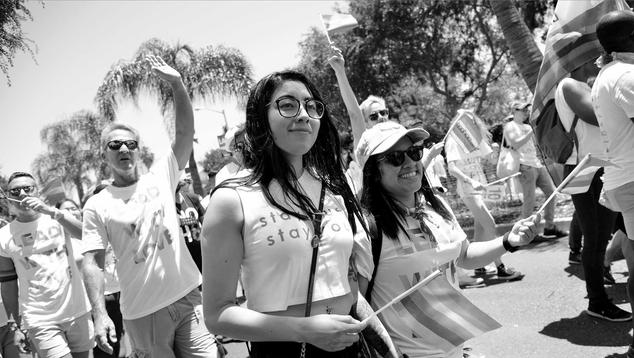Story Highlights
- U.S. adults estimate that 23.6% of Americans are gay or lesbian
- Women, young adults have the highest estimations of gay population
This article is the fourth in a monthlong series on Americans' views about LGBT issues. Gallup has released new findings every Thursday in June. Gallup's trends, including some extending back four decades, can be found here.
WASHINGTON, D.C. -- U.S. adults estimate that nearly one in four Americans (23.6%) are gay or lesbian. Gallup has previously found that Americans have greatly overestimated the U.S. gay population, recording similar average estimates of 24.6% in 2011 and 23.2% in 2015. In each of the three polls in which Gallup has asked this question, a majority of Americans estimated this population to be 20% or greater.
| May 2011 | May 2015 | May 2019 | |||||||||||||||||||||||||||||||||||||||||||||||||||||||||||||||||||||||||||||||||||||||||||||||||
|---|---|---|---|---|---|---|---|---|---|---|---|---|---|---|---|---|---|---|---|---|---|---|---|---|---|---|---|---|---|---|---|---|---|---|---|---|---|---|---|---|---|---|---|---|---|---|---|---|---|---|---|---|---|---|---|---|---|---|---|---|---|---|---|---|---|---|---|---|---|---|---|---|---|---|---|---|---|---|---|---|---|---|---|---|---|---|---|---|---|---|---|---|---|---|---|---|---|---|---|
| % | % | % | |||||||||||||||||||||||||||||||||||||||||||||||||||||||||||||||||||||||||||||||||||||||||||||||||
| Mean | 24.6 | 23.2 | 23.6 | ||||||||||||||||||||||||||||||||||||||||||||||||||||||||||||||||||||||||||||||||||||||||||||||||
| Less than 5% | 4 | 9 | 8 | ||||||||||||||||||||||||||||||||||||||||||||||||||||||||||||||||||||||||||||||||||||||||||||||||
| 5% to less than 10% | 9 | 11 | 9 | ||||||||||||||||||||||||||||||||||||||||||||||||||||||||||||||||||||||||||||||||||||||||||||||||
| 10% to less than 15% | 17 | 14 | 14 | ||||||||||||||||||||||||||||||||||||||||||||||||||||||||||||||||||||||||||||||||||||||||||||||||
| 15% to less than 20% | 9 | 7 | 10 | ||||||||||||||||||||||||||||||||||||||||||||||||||||||||||||||||||||||||||||||||||||||||||||||||
| 20% to 25% | 17 | 20 | 19 | ||||||||||||||||||||||||||||||||||||||||||||||||||||||||||||||||||||||||||||||||||||||||||||||||
| More than 25% | 35 | 33 | 35 | ||||||||||||||||||||||||||||||||||||||||||||||||||||||||||||||||||||||||||||||||||||||||||||||||
| Gallup | |||||||||||||||||||||||||||||||||||||||||||||||||||||||||||||||||||||||||||||||||||||||||||||||||||
Americans' estimate of the proportion of gay people in the U.S. is more than five times Gallup's more encompassing 2017 estimate that 4.5% of Americans are LGBT, based on respondents' self-identification as being lesbian, gay, bisexual or transgender.
In 2002, Gallup asked Americans to estimate the proportion of men and women who are gay or lesbian, respectively. The results were nearly identical, with an average estimate that 21% of men and 22% of women were gay.
As Gallup pointed out in its initial estimate of the entire LGBT population in 2012, "Exactly who makes up the LGBT community and how this group should be measured is a subject of some debate," and "there are a number of ways to measure lesbian, gay, and bisexual orientation, and transgender status. Sexual orientation can be assessed by measuring identity as well as sexual behaviors and attractions." Thus, Gallup's methodology is not the only way to estimate the percentage of the population that is gay or lesbian. Still, all available estimates of the actual gay and lesbian population in the U.S. are far lower than what the public estimates, and no measurement procedure has produced any figures suggesting that more than one out of five Americans are gay or lesbian.
Overestimations of the nation's gay population may in part be due to the group's outsized visibility. An annual report by GLAAD, an LGBT advocacy group, found that representation of LGBT people as television series regulars on broadcast primetime scripted programming reached an all-time high of 8.8% in the 2018-2019 television season, which is nearly twice Gallup's estimate of the actual population.
But Americans have overestimated the sizes of other minority groups in the past as well, including U.S. blacks and Hispanics.
Women, Young Adults Have Highest Estimations of U.S. Gay Population
U.S. women estimate that about three in 10 Americans (29.7%) are gay or lesbian -- the highest of any key subgroup, and much higher than men's perceptions (17.4%).
Meanwhile, average estimates of the U.S. gay population vary by age. Adults aged 18 to 29 offer the highest estimate (28.5%), and adults aged 65 and older, the lowest (17.5%).
Among political partisans, Democrats and independents estimate that about a quarter of Americans are gay or lesbian, while the average approximation among Republicans is a bit lower (18.3%).
Even the groups offering the lowest average estimates of gays and lesbians in the U.S. exceed Gallup's figure on all LGBT identification by about four times.
| Mean estimate | |||||||||||||||||||||||||||||||||||||||||||||||||||||||||||||||||||||||||||||||||||||||||||||||||||
|---|---|---|---|---|---|---|---|---|---|---|---|---|---|---|---|---|---|---|---|---|---|---|---|---|---|---|---|---|---|---|---|---|---|---|---|---|---|---|---|---|---|---|---|---|---|---|---|---|---|---|---|---|---|---|---|---|---|---|---|---|---|---|---|---|---|---|---|---|---|---|---|---|---|---|---|---|---|---|---|---|---|---|---|---|---|---|---|---|---|---|---|---|---|---|---|---|---|---|---|
| % | |||||||||||||||||||||||||||||||||||||||||||||||||||||||||||||||||||||||||||||||||||||||||||||||||||
| Men | 17.4 | ||||||||||||||||||||||||||||||||||||||||||||||||||||||||||||||||||||||||||||||||||||||||||||||||||
| Women | 29.7 | ||||||||||||||||||||||||||||||||||||||||||||||||||||||||||||||||||||||||||||||||||||||||||||||||||
| 18-29 | 28.5 | ||||||||||||||||||||||||||||||||||||||||||||||||||||||||||||||||||||||||||||||||||||||||||||||||||
| 30-49 | 24.4 | ||||||||||||||||||||||||||||||||||||||||||||||||||||||||||||||||||||||||||||||||||||||||||||||||||
| 50-64 | 23.1 | ||||||||||||||||||||||||||||||||||||||||||||||||||||||||||||||||||||||||||||||||||||||||||||||||||
| 65+ | 17.5 | ||||||||||||||||||||||||||||||||||||||||||||||||||||||||||||||||||||||||||||||||||||||||||||||||||
| Republicans | 18.3 | ||||||||||||||||||||||||||||||||||||||||||||||||||||||||||||||||||||||||||||||||||||||||||||||||||
| Independents | 25.2 | ||||||||||||||||||||||||||||||||||||||||||||||||||||||||||||||||||||||||||||||||||||||||||||||||||
| Democrats | 26.3 | ||||||||||||||||||||||||||||||||||||||||||||||||||||||||||||||||||||||||||||||||||||||||||||||||||
| Gallup, May 15-30, 2019 | |||||||||||||||||||||||||||||||||||||||||||||||||||||||||||||||||||||||||||||||||||||||||||||||||||
Bottom Line
Gallup has seen the percentage of self-identifying LGBT people grow among millennials, who are making up an increasing share of the U.S. adult population. It is, therefore, possible that Americans' perceptions of the gay population may be influenced by the greater representation they see among young people. This also likely explains why younger adults produce higher estimations, as LGBT self-identifiers make up a larger share of their peers than is the case for older Americans.
There are numerous ways to calculate the size of the LGBT population, which Gallup and other academics continue to study and test. It's quite possible that LGBT self-identifiers will increase as a result of changes in societal norms and acceptance.
Still, no available estimate is as high as what Americans perceive the size of the U.S. gay and lesbian population to be.
Learn more about how the Gallup Poll Social Series works.




